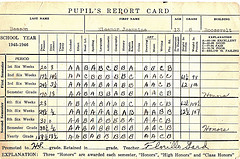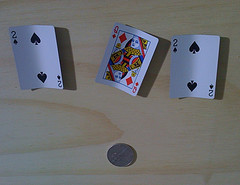“How can I help you?”
The principal was polite, but somewhat reserved. This was our first meeting with her. Contrary to what my wife and I had heard from other parents, she was neither fire-breathing nor scary. Sure, with her hair in a tight bun, a somewhat conservative raised-collar white shirt and severely cut skirt, she looked more like an up-and-coming corporate marketing executive than the principal of an elementary school. Her reputation was as a no-nonsense disciplinarian.
Sometime early in our meeting, the atmosphere turned from the formal and somewhat frigid start to a whole lot warmer and practically collegial. We realized this had happened once the principal knew we were not there to discuss our older daughter who was already in the school but that we’d had asked for the meeting as a prelude to admitting our younger one. In fact things got comfortable enough that somewhere in there she alluded to the fact that she always gets tremendous pressure from “Asian” parents.
Of course, in California and much of the U.S., the word Asian, particularly in an educational context, is used to refer to the arc of peoples from Japan through Indo-China to China itself. Rarely are South Asians, including Indians or West Asians, referred to as Asians.
In this instance, the principal referred to the preponderance of Indian and Chinese parents who wanted their kids to start earlier at school, get more homework, have even more activities for their kids — in other words these parents were COMPETITIVE. Her relief was palpable that we’d merely come to discuss our child’s admission.
I could certainly empathize with her and did not want to be in her shoes at a parent teacher meeting. Hah, but little did I know that I’d soon be stepping into the proverbial fire from the frying pan when my family and I relocated to Bangalore.
“Excuse me, excuse me!” the lady was persistent. About 40 of us, all parents of tenth-graders were in a meeting with the principal, this time at a school in Bangalore. The family and I have been back in India for nearly five years and our older child is in the 10th grade. The principal, this time in a starched saree but just as businesslike and no-nonsense as her Californian counterpart, was trying to address all the questions the parents had — and they had a few!
The Central Board of Secondary Education earlier this year announced its most significant reforms since the current “10 plus 2″ system of secondary education was rolled out in 1977. They were doing away with the “Board Exams.”
Across 11,500-plus schools in India each year, nearly 1.5 millions students appear for these examinations. For three decades, this single exam, taken at the end of the 10th grade, has determined what educational streams Indian kids can pursue in grades 10 and 11. Science, Commerce or the Arts are the most common choices. This choice, in turn, determines what college majors they can apply for.
No prizes for guessing the two popular choices — medicine or engineering, both of which require science and math in 10th and 11th grades.
Our children’s school was one of the few CBSE “senior secondary” schools in our city, meaning they offered 11th and 12th grades while most others only went to tenth. So if you wanted your kid to stay in high school for 11th and 12th grades, they had to compete with not just their classmates, but kids graduating from tenth grade in other schools.
“What if my child does not get admission in the science stream in 11th class at your school?” said the persistent parent. I could feel the collective nods of nearly every other parent in the room as they strained to hear the principal’s answer.
“Shouldn’t you give preference for your own students first?” pressed another parent before the principal could respond.
Like an angry town hall or shareholder meeting, the mood in the room was tense as parents tried to determine if their kid would get into the Science section.
“As long as your kids score A grade or better (80% or more) in science and math, they will be given admission in our own school,” the principal tried to assure the gathering.
“And if we are transferred or have to move, would other schools accept the grades the school gives out?” a couple from the front row asked in tandem.
“Let me speak plainly,” piped in a dad. “Your school exams have been a lot tougher than the Board exams in the past. Wouldn’t it be better if our children took the Boards? Wouldn’t that allow them to compete on a level playing field with kids from other schools?”
To her credit, the principal kept her cool as the parents continued to pepper her with questions.
While my wife, and at times one of my children, had regaled me with tales of moms who showed up at school wanting to know why a teacher had knocked off a mark or two from their child’s class test, I had not encountered this face of the anxious — at times angry — Indian school parent.
Even as the buzz of parents talking to one another grew, I put my hand up. Once I caught the principal’s eye, I asked: “Is the discussion so far pertaining only to admission for Science majors? What about Arts major?”
You could have cut the shocked silence with a knife.
“If 25 parents are prepared to commit in writing that they will send their child to an Arts major, I am prepared to offer one,” the principal said. “Otherwise anything other than Science doesn’t have enough takers.”
That evening, I took a poll of about 20 people — colleagues at work, neighbors and college mates — nearly all of whom had trained formally as engineers. Most hadn’t practiced engineering in two decades. One had become a restaurateur, several were real estate developers, others run businesses ranging from an adventure outfit to advertising agencies. Several were in teaching, general management and consulting. Many were still considering career changes. And these were the successful ones.
So why do we as parents expect our children to make up their minds at 15 or 16 and, worse yet, determine that they should all be mindlessly studying for professional courses? At the end of the eighth grade, many kids take a test to be admitted to a coaching class for taking engineering or medical entrance exams four years later!
From the ninth through 12th grades, their evenings and Saturdays are spent boning up for entrance exams. Each year, we read of ever more kids killing themselves after their 10th or 12th grade exams unable to take the pressure.
Only when we win an elusive gold at the Olympics (can we name two Indians in the last four years) or an even rarer Nobel Prize, as happened with Venkatraman Ramakrishnan in 2009, do we as Indians seem to think that there are worthwhile pursuits outside of being a doctor or an engineer.
But I am rambling. I had better stop here and rush to get into the queue for admitting my child in the special prep class for her tenth grade exam!
This article first appeared online in the Wall Street Journal in October 2010.
 As in my worst fears, the call came early in the morning, just before 3AM California time. When the phone rang the first time, I rejected the call, reckoning it was a colleague in India, who’d lost track of time. When the phone rang again within minutes, this time with caller ID showing another colleague’s name, I knew something was amiss.
As in my worst fears, the call came early in the morning, just before 3AM California time. When the phone rang the first time, I rejected the call, reckoning it was a colleague in India, who’d lost track of time. When the phone rang again within minutes, this time with caller ID showing another colleague’s name, I knew something was amiss.











You must be logged in to post a comment.